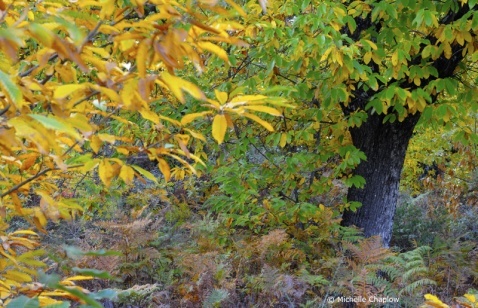
The Sierra de Aracena and Picos de Aroche natural park |
|
Home | Accommodation | Fauna | Rivers | Suggested routes | Things to see | Walks
Sierra de Aracena y los Picos de Aroche Natural Park - Flora
Flora
With a comparatively high annual rainfall of around 1,000mm, the Sierra has extensive and often dense vegetation.
The Sierra was originally covered by Mediterranean woodland of mainly gall, cork and holm oaks. Some of this was cleared in the Middle Ages to make way for the dehesa (mixed woodland and pastureland), which at the time was common land. The dehesa is still very much in evidence today and is used for the production of cork, firewood, charcoal (from holm oaks) and the grazing of livestock. It occupies over a third of the park today and is confined to the shallower gradients.
The best times to visit the Sierra is in spring for the abundant wildflowers and in autumn for the magnificent changing colours of the trees, especially the sweet chestnuts.
 |
| The spectacular Autumn leaves in the Sierra de Aracena |
There are many varieties of wild mushroom in autumn, which you can sample in the area's bars and restaurants. The ones most commonly seen are Caesar mushrooms or tanas in spanish (amanita caesarea); boletus (boletus edulis); chanterelles or pinateles (lactarius deliciosus) often found under pine trees and also known as níscalos in spanish; and parasol mushrooms, gallipiernos in spanish (macrolepiota procera) that can be found in chestnut groves.
The Sierra has 50 flower species that are endemic to mainland Spain and Portugal and northern Africa. The list of wildflowers seen here is long: poppies, wild irises, primroses, Spanish bluebells, peonies, star-of-Bethlehem, asphodels, wild tulips, soapwort, tassel hyacinths and wild majoram, among others. In spring the fields are smothered in colourful flowers.
Rock roses are common under pine woods, with delicate, large white or pink petals and yellow centres.
In drier parts there are prickly pear cacti.
Trees
The trees are mainly Mediterranean oak: holm (quercus ilex), cork (quercus suber), Kermes or holly oak (quercus coccifera) and gall. Underneath these trees is vegetation typical of Mediterranean scrubland or matorral: lentisc, wild oregano, lavender, wild roses, heather, hawthorn and myrtle.
Within the park the Monumento Natural Dehesa de San Francisco, covering 1,953m sq near Santa Olalla, has been designated a protected area due to its magnificent holm oaks (quercus ilex subsp. rotundifolia). It is an example of the original Mediterranean forest that centuries ago colonised the Sierra.
Also characteristic of the matorral and widespread in the Sierra is the strawberry tree (arbustus unedo), a small evergreen that is easier to spot when they fruit in autumn and winter. The 'strawberries' are 2cm wide and have bumpy red skin and yellow flesh.
The sweet or Spanish chestnut (castanea sativa) likes acidic, well-drained soils and can grow on steep slopes. There are 6,000 hectares of castaños mainly in the centre of the park, around Aracena, Fuenteheridos, Castaño del Robledo and Galaroza. It is pruned heavily to maximise the chestnut crop, so that the trees here appear to be rather stunted with a typically short trunk. Chestnuts are an important source of income and seasonal employment in the Sierra. Most of them are exported but in the autumn you can buy them locally and roast them on the fire. Look out for other products sold in shops in the Sierra, like crema de castaña (creamed chestnut) and chestnut paté. Chestnut wood is used in furniture produced locally, mainly in Galaroza.
Ash, alders, willows, poplar groves and oleander shrubs line the fertile river valleys. The best rivers to visit for flora and fauna are the Río Múrtigas, from Galaroza northwest towards Encinasola; Rivera de Chanza, from Cortegana to north of Aroche; Arroyo Guijarra, near Cortelazor (with a shady picnic area and a good swimming spot) and Rivera de Huelva, north of Aracena and Zufre.
In the 19th century many olive trees were planted and these are concentrated today around Aracena, Aroche, Cortegana and Zufre.
Between Fuenteheridos and Galaroza are many apple and pear orchards. Historically, this was an important apple-producing area . It produces a hybrid apple/pear known locally as a pero. The nickname for people from Galaroza, cachonero, comes from a type of apple that used to be grown here.
The south-facing side of the Sierra has more citrus trees, such as lemon, orange and tangerine. Fig and walnut trees are also common here.
In winter look out for bare trees with orange fruit hanging on the branches. These are persimmon trees, the fruit and tree known in spanish as caqui.
Some areas have been reforested with pine trees and, more recently, eucalyptus trees, like the Contienda north of Aroche, the hills between Aracena and Castañuelo and near Zufre. This reforestation has had a negative impact on the area's flora, fauna and soil.
ACCOMMODATION
Hotels in the main towns and villages. Bed & Breakfast and casas rurales (country cottages) in beautiful rural locations. More on Sierra de Aracena accommodation page >